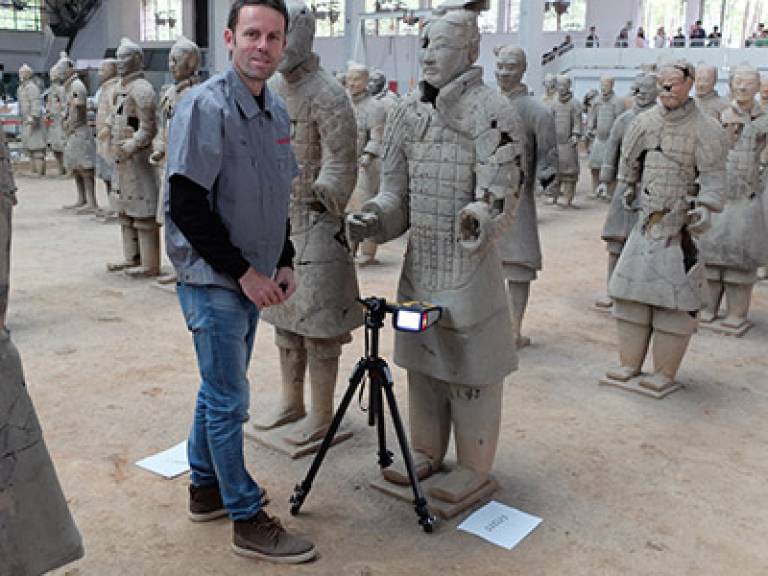AHRC Capability for Collections funding success for pXRF facilities
4 March 2021
A joint bid to the AHRC Capability for Collections fund (CapCo) from the UCL Institute for Sustainable Heritage, UCL Institute for Archaeology and UCL Culture has been awarded funding.

The AHRC funding will enable UCL to invest in three new hyperspectral imaging (HSI) cameras to upgrade existing imaging capability at the Institute for Sustainable Heritage and three portable x-ray fluorescence (pXRF) instruments to replace existing equipment in the Institute of Archaeology.
Since 2008, Institute of Archaeology researchers have applied portable x-ray fluorescence (pXRF) to the analysis of a wide range of archaeological materials in order to determine their elemental composition. Full advantage has been taken of the benefits of pXRF technology which has been applied to the study of some of the world’s most valuable and renowned archaeological finds.
Institute researchers have used pXRF equipment at Emperor Qin Shihuang’s Mausoleum in China, since 2014, analysing the ceramic statues of the Terracotta Army and bronze weapons unearthed with them at this UNESCO World Heritage Centre (Martinón-Torres et al. 2014, 2019; Quinn et al. 2020). Our experience with pXRF has been a key aspect in granting us access to these heavily protected artefacts.
In addition to its research applications, pXRF has been used widely for teaching and training purposes at undergraduate and postgraduate level at the Institute of Archaeology. It can be deployed in the classroom for group demonstrations and students can safely apply it to individual research projects after relatively brief training. pXRF equipment is also used in recruitment and outreach activities.
The acquisition of three state-of-the-art Olympus ‘Vanta’ machines will ensure that the Institute of Archaeology remains at the forefront of research into ancient materials and will support what is an expanding area of activity. It will also open this technology up to a wider range of potential users and different applications within UCL.
The equipment will be housed in the Wolfson Archaeological Science Laboratories and managed by Patrick Quinn, Principal Research Fellow in Ceramic Petrography. It will be available for researchers across the university to use through the UCL Research Equipment Catalogue.

Relevant research
- Adlington, L. W., and Freestone, I. C. 2017. Using handheld pXRF to study medieval stained glass: A methodology using trace elements. Materials Research Society Advances, 33/34: 1785–1800.
- Burton, M., Quinn, P. S., Tamberino, A., and Levy, T. 2019. Ceramic composition at Chalcolithic Shiqmim, northern Negev desert, Israel: investigating technology and provenance using thin section petrography, instrumental geochemistry, and calcareous nannofossils. Levant, 50: 235–257.
- Lewis, M. P., Quinn, P. S. and Carter, R. 2020. Uruk expansion or integrated development? A petrographic and geochemical perspective from Gurga Chiya, Iraqi Kurdistan. Journal of Archaeological Science Reports, 33 (https://doi.org/10.1016/j.jasrep.2020.102516)
- Lozada Mendieta, N. 2019. Ancient Pots and Potters of the Atures Rapids Region: Occupation and Interaction Processes in Pre-Colonial Middle Orinoco, Venezuela. Unpublished doctoral thesis, Institute of Archaeology, University College London.
- Martinón-Torres, M., Li, X., Xia, Y., Bevan, A., Ma, S., Huang, J., Wang, L., Lan, D., Liu, J., Zhao, Z., Zhao, K., and Rehren, T. 2019. Surface chromium on Terracotta Army bronze weapons is neither an ancient anti-rust treatment nor the reason for their good preservation. Nature Scientific Reports, 5289: 1–11.
- Martinón-Torres, M., Li, X., Bevan, A., Xia, Y., Zhao, K., and Rehren, T. 2014. Forty thousand arms for a single emperor: from chemical data to labor organization in the production of bronze arrows for the Terracotta Army. Journal of Archaeological Method and Theory, 21: 534–562.
- Mills, J. R. 2020. Tracking the Hunters: Geochemical Profiling of Middle Palaeolithic Stone Artefacts to Reconstruct Neanderthal Landscape Use in the La Manche Region. Unpublished doctoral thesis, Institute of Archaeology, University College London.
- Quinn, P. S., Ying, Y., Xia, Y., Li, X., Ma, S. and Wilke, D. 2020. Geochemical Evidence for the Manufacture, Logistics and Supply-Chain Management of Emperor Qin Shihuang’s Terracotta Army, China. Archaeometry (https://doi.org/10.1111/arcm.12613)
- Sorresso, D. C. and Quinn, P. S. 2020. Re-examining Shell-Tempered Chickasaw Pottery in Post-contact Mississippi, USA. Journal of Archaeological Science Reports, 32 (https://doi.org/10.1016/j.jasrep.2020.102415)
 Close
Close

